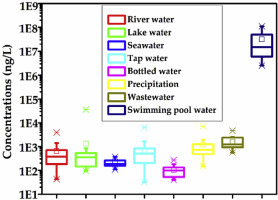Environmental Pollution ( IF 7.6 ) Pub Date : 2019-12-07 , DOI: 10.1016/j.envpol.2019.113743 Hongkai Zhu , Kurunthachalam Kannan

|
The extensive use of melamine and its three derivatives (i.e., ammeline, ammelide, and cyanuric acid) resulted in their widespread occurrence in the environment. Nevertheless, limited information is available on their distribution in the aquatic environment. In this study, concentrations and profiles of melamine and its derivatives were determined in 223 water samples, comprising river water, lake water, seawater, tap water, bottled water, rain water, wastewater, and swimming pool water, collected from New York State, USA. The sum concentrations of melamine and its derivatives (∑4MELs) decreased in the following order: swimming pool water (median: 1.5 × 107 ng/L) ≫ wastewater (1240) > precipitation (739) > tap water (512) > river water (370) > lake water (347) > seawater (186) > bottled water (98). Cyanuric acid was the major compound, accounting for 60–100% of ∑4MELs concentrations in swimming pool water, wastewater, precipitation, tap water, seawater, and bottled water, whereas melamine dominated in river and lake water (54–64% of ∑4MELs). Significant positive correlations (0.499 < R < 0.703, p < 0.002) were found between the concentrations of melamine and atrazine concentrations in surface waters. The geographic distribution in the concentrations of ∑4MELs in river, lake, and tap water corresponded with the degree of urbanization, suggesting that human activities contribute to the sources of these chemicals in the aquatic environments. A preliminary hazard assessment of melamine and cyanuric acid in water suggested that their ecological or human health risks were minimal. This is the first study to document the occurrence and spatial distribution of melamine and its derivatives in waters from the United States.
中文翻译:

三聚氰胺及其衍生物在地表水,饮用水,降水,废水和游泳池水中的发生和分布
三聚氰胺及其三种衍生物(即氨甲林,乙酰胺和氰尿酸)的广泛使用导致它们在环境中的广泛存在。然而,关于它们在水生环境中的分布的信息很少。在这项研究中,测定了纽约州收集的223个水样中三聚氰胺及其衍生物的浓度和分布,这些水样包括河水,湖水,海水,自来水,瓶装水,雨水,废水和游泳池水,美国。三聚氰胺的总和的浓度和它的衍生物(Σ 4 MELS)按以下顺序降低:游泳池水(中位数:1.5×10 7 ng / L)≫废水(1240)>降水(739)>自来水(512)>河水(370)>湖水(347)>海水(186)>瓶装水(98)。氰尿酸是主要化合物,占游泳池水,废水,降水,自来水,海水和瓶装水中∑ 4 MELs浓度的60–100%,而三聚氰胺在河流和湖泊水中占主导(54-64% ∑ 4个MEL)。 在地表水中三聚氰胺的浓度与at去津的浓度之间存在显着的正相关(0.499 < R <0.703,p <0.002)。∑ 4浓度的地理分布河流,湖泊和自来水中的最低有效物质与城市化程度相对应,表明人类活动是水生环境中这些化学物质的来源。水中三聚氰胺和氰尿酸的初步危害评估表明,它们的生态或人类健康风险最小。这是第一个记录三聚氰胺及其衍生物在美国水域中的发生和空间分布的研究。













































 京公网安备 11010802027423号
京公网安备 11010802027423号